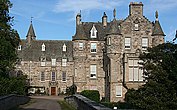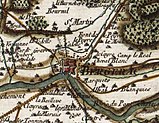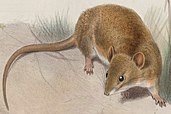| << | Today's featured articles for October 2021 | >> | ||||
|---|---|---|---|---|---|---|
| Su | Mo | Tu | We | Th | Fr | Sa |
| 1 | 2 | |||||
| 3 | 4 | 5 | 6 | 7 | 8 | 9 |
| 10 | 11 | 12 | 13 | 14 | 15 | 16 |
| 17 | 18 | 19 | 20 | 21 | 22 | 23 |
| 24 | 25 | 26 | 27 | 28 | 29 | 30 |
| 31 | ||||||
October 1

The Gateway Protection Programme was operated by the British government between 2004 and 2020, in partnership with the United Nations High Commissioner for Refugees (UNHCR) and co-funded by the European Union, offering a legal route for a quota of UNHCR-identified refugees to settle in the United Kingdom. It was proposed by the British Home Secretary, David Blunkett, in October 2001, and its legal basis was established by the Nationality, Immigration and Asylum Act 2002. The programme launched in March 2004, initially with a quota of 500 and later 750 refugees per year, but the actual number of refugees resettled in most years was fewer than the quota permitted. Evaluations of the programme have praised it but noted problems in securing employment for refugees. In March 2020, the Gateway Protection Programme closed after resettling 9,939 refugees, including Congolese, Somali, Iraqi, Ethiopian, Sudanese and Burmese nationals. A new UK Resettlement Scheme started in February 2021. (Full article...)
October 2
The Eurasian blackcap (Sylvia atricapilla) is a typical warbler in Europe, western Asia and northern Africa. It has grey upperparts and paler grey underparts, and the male has a black cap, while the female's is reddish-brown. The male's song is a rich musical warbling. The blackcap builds a neat cup nest in scrub, often in mature deciduous woodland. The female lays four to six buff eggs, which hatch in about 11 days. The chicks fledge in 11–12 days, but are fed by both adults for some time after. Birds from the colder areas of the range migrate, wintering in scrub in western Europe, around the Mediterranean and in Africa. Some German birds winter in gardens in the British Isles. Blackcaps eat insects when breeding, but otherwise survive primarily on small fruit; garden birds also eat bread, fat and peanuts in winter. The blackcap's range has been expanding, even though it is hunted in some countries. Its rich song has been featured in literature, films and music. (Full article...)
October 3
Charles Duke (born October 3, 1935) is a former astronaut, United States Air Force (USAF) officer and test pilot. As the lunar module pilot of Apollo 16 in 1972, he became (and remains) the tenth and youngest person to walk on the Moon. A 1957 graduate of the United States Naval Academy who joined the USAF, Duke completed his advanced flight training at Moody Air Force Base, and became a fighter pilot. He graduated from the Aerospace Research Pilot School in September 1965, and stayed on as an instructor. In April 1966, he was one of nineteen men selected for NASA's fifth group of astronauts. As a CAPCOM for Apollo 11, the first crewed landing on the Moon, in July 1969, his distinctive Southern drawl became familiar to audiences around the world. Duke was backup lunar module pilot for Apollo 13. On the Apollo 16 mission, Duke and John Young landed at the Descartes Highlands and conducted three excursions. He retired from NASA in 1976, and from the USAF in 1986 with the rank of brigadier general. (Full article...)
October 4

Solo Man (Homo erectus soloensis) is the last known subspecies of Homo erectus, existing 117 to 108 thousand years ago along the Solo River in Java, Indonesia. First discovered in 1931, the subspecies was originally considered a direct ancestor of Aboriginal Australians, in accordance with historical race concepts. Solo Man probably has no living descendants, since the remains far predate modern human immigration into the area. The skull is elongated, and has inflated brows and cheekbones. Brain volume was large for the species, with some fossils indicating 1,013 to 1,251 cubic centimeters (61.8 to 76.3 cu in). The subspecies inhabited an open woodland environment much cooler than present-day Java, and probably went extinct with the replacement of this habitat by tropical rainforest. Solo Man manufactured simple stone tools, and possibly also made spears or harpoons from bones, daggers from stingray stingers, and bolas or hammerstones from andesite. (Full article...)
October 5
Tecumseh (c. 1768 – October 5, 1813) was a Shawnee chief and warrior who promoted resistance to the expansion of the United States onto Native American lands. During Tecumseh's childhood, the Shawnee lost territory to the American colonies in a series of border conflicts. A persuasive orator, Tecumseh traveled widely, forming a Native American confederacy and promoting tribal unity. He proclaimed that Native Americans owned their lands in common, and urged tribes not to cede more territory unless all agreed. In the War of 1812, Tecumseh joined his cause with the British, recruiting warriors and helping to capture Detroit in 1812. In 1813, he retreated with the British into Upper Canada, where American forces engaged them at the Battle of the Thames, in which Tecumseh was killed. His death led to the collapse of his confederacy, but he became an iconic folk hero in American, Indigenous, and Canadian history. (Full article...)
October 6
The Long Island Tercentenary half dollar is a commemorative coin struck by the United States Bureau of the Mint in 1936. The obverse (pictured) depicts a male Dutch settler and an Algonquian tribesman, and the reverse shows a Dutch sailing ship. It was designed by Howard Weinman, son of Mercury dime designer Adolph A. Weinman. The Long Island Tercentenary Committee wanted a coin to mark the 300th anniversary of the first European settlement there. The authorizing bill passed through Congress without opposition, but was amended in the Senate to add protections against past commemorative coin abuses, such as low mintages or a multiplicity of varieties. The coins were not struck until August 1936, too late for the anniversary celebrations. Four-fifths of the 100,000 coins sent to the Tercentenary Committee were sold, despite a lack of advertising. The half dollar now catalogues up to the low hundreds of dollars. (Full article...)
October 7
Cullen House is the former seat of the Earls of Seafield near the coastal town of Cullen in Moray, Scotland. Initially built in 1600, it has been extended and remodelled several times by prominent architects such as James Adam, John Adam, and David Bryce, and has been described by the architectural historian Charles McKean as "one of the grandest houses in Scotland". The house was taken by the Marquess of Montrose in 1645 during the Wars of the Three Kingdoms, and it was sacked by Jacobite forces during the rising of 1745, shortly before their defeat at the Battle of Culloden. The village of Cullen was mostly demolished in the 1820s to make way for expansion of the gardens by the 5th Earl of Seafield. The building deteriorated during the twentieth century, and in 1982 Ian Ogilvie-Grant sold it to Kit Martin, who worked to save the structure while dividing it into fourteen individual dwellings, still in use today. Further restoration was needed after a serious fire broke out in 1987. (Full article...)
October 8
Accolade, Inc. was an American game developer and publisher based in San Jose, California. The company was founded in 1984 by Alan Miller and Bob Whitehead, who had previously co-founded Activision. Accolade became known for its sports franchises, including HardBall!, Jack Nicklaus, and Test Drive. By the 1990s, Accolade saw critical acclaim for Star Control, as well as strong sales for Bubsy. However, Sega sued Accolade for creating unauthorized Sega Genesis games by reverse-engineering the console. Accolade won the case on appeal, overturning an injunction that had interrupted their sales. The founders soon left the company and a new chief executive, Peter Harris, attracted new investment. He was replaced by Accolade president Jim Barrett, who focused on existing franchises to secure the company's future, which led to a mix of modest successes and commercial disappointments. In 1999, Accolade was purchased by Infogrames, who absorbed them into their operations soon after. (Full article...)
October 9
The eastern brown snake (Pseudonaja textilis) is a highly venomous snake of the family Elapidae, native to eastern and central Australia and southern New Guinea. Up to 2.4 metres (7.9 ft) long with a slender build, it has variable upperparts, pale brown to almost black, and a pale cream-yellow underside, often with orange or grey splotches. It was first described by André Marie Constant Duméril in 1854. The eastern brown snake is found in many habitats, though not in dense forests. It has become more common in farmland and on the outskirts of urban areas, preying mainly on the introduced house mouse. It is considered the world's second-most venomous land snake after the inland taipan, based on the toxicity of its venom in mice. According to one study, as a genus, brown snakes were responsible for 15 of 19 snakebite fatalities in Australia between 2005 and 2015. The venom mainly affects the circulatory system, causing bleeding, cardiovascular collapse and cardiac arrest. (Full article...)
October 10

Hurricane Rosa brought widespread flooding to northwestern Mexico and the Southwestern United States in late September 2018, leading to one death in Mexico and two in the U.S. state of Arizona. Rosa originated from an Atlantic tropical wave that crossed the West African coast on September 6. The wave proceeded westward across the Atlantic, traversing Central America before entering the Gulf of Tehuantepec on September 22. It became a tropical storm three days later. Rosa entered a period of rapid intensification on the 27th, peaking as a Category 4 hurricane with maximum sustained winds of 150 mph (240 km/h) a day later. It thereafter weakened, making landfall in Baja California as a tropical depression on October 2, and split apart by the following day. There were tropical storm watches and warnings along the coast of Baja California, but the impact of Rosa was relatively minor, due to the weakness of the storm by the time it made landfall. (This article is part of a featured topic: 2018 Pacific hurricane season.)
October 11

"Home" is the second episode of the fourth season of the American science fiction television series The X-Files, which originally aired on the Fox network on October 11, 1996. Directed by Kim Manners and written by Glen Morgan and James Wong, it is a "monster-of-the-week" story, unconnected to the overarching mythology of The X-Files. Watched by 18.85 million viewers, the initial broadcast had a Nielsen rating of 11.9. The series centers on FBI special agents Fox Mulder (David Duchovny) and Dana Scully (Gillian Anderson), who work on cases linked to the paranormal. In this episode, Mulder and Scully investigate the death of a baby born with severe physical defects. While in the isolated town of Home, Pennsylvania, they meet a family of deformed farmers who have not left their home in a decade. "Home" was the first episode of the series to receive a viewer discretion warning for graphic content. (Full article...)
October 12

United States v. Washington was a case heard in the U.S. District Court for the Western District of Washington and the U.S. Ninth Circuit Court of Appeals. It reaffirmed the right of American Indian tribes in the State of Washington to act with the state as co-managers of salmon and other fish in line with treaties signed by the U.S. with the tribes. The tribes of Washington had ceded their land, but reserved the right to fish using traditional methods (example pictured), including at traditional locations off the designated reservations. A 1974 decision by federal judge George Boldt held that the tribes were entitled to half the catch each year. In 1975 the Ninth Circuit Court of Appeals upheld this ruling, and in 1976 the U.S. Supreme Court declined to hear the case. When the state refused to enforce the court order, Boldt ordered the Coast Guard to enforce his rulings. In a later case, Justice John Paul Stevens summarized: "Both sides have a right, secured by treaty, to take a fair share of the available fish." (Full article...)
October 13
The Battle of Bergerac was fought between Anglo-Gascon and French forces at the town of Bergerac in Gascony, in August 1345 during the early phase of the Hundred Years' War. In early 1345 Edward III of England launched a major attack on the French from the north. He sent smaller forces to Gascony, which was economically important to the English war effort, and to Brittany. Henry of Grosmont, Earl of Derby, arrived in Gascony in August; breaking with the previous policy of cautious advance, he struck directly for the largest French concentration at Bergerac. He took French forces under Bertrand I of L'Isle-Jourdain and Henri de Montigny by surprise and defeated them. The French suffered heavy casualties and the loss of the town, a significant strategic setback. This defeat, along with the Battle of Auberoche later in the year, changed the military balance of power in the region and led to the collapse of the French position. (This article is part of a featured topic: Gascon campaign of 1345.)
October 14
Doug Ring was a member of the Australian cricket team that toured England in 1948. Ring played under captain Donald Bradman, whose 1948 team went undefeated in their 34 matches, earning them the sobriquet "The Invincibles". A leg spinner, Ring was not prominent in the series, playing in only the Fifth Test, taking one wicket for 44 runs and scoring nine runs in his only innings. Ring took 60 first-class wickets at a bowling average of 21.81, the most expensive among Australia's frontline bowlers. As England agreed to have a new ball available at intervals of 55 overs after the start of each innings, fast bowling dominated over spin in the Tests, and Ring was used primarily in the non-Test tour matches. Ring scored 150 first-class runs at a batting average of 16.66 during the tour, and a top-score of 53 was his only effort beyond 50. (This article is part of a featured topic: Australian cricket team in England in 1948.)
October 15
Kaikhosru Shapurji Sorabji (1892–1988) was an English composer, music critic, pianist and writer whose music, written over a period of seventy years, ranges from sets of miniatures to works lasting several hours. One of the most prolific 20th-century composers, he is best known for his piano pieces, notably nocturnes such as Gulistān, and large-scale, technically intricate works like Sequentia cyclica. He had a lifelong tendency to seclusion and felt alienated from English society by reason of his homosexuality and ancestry; his mother was English and his father a Parsi businessman and industrialist from India. After playing his music publicly between 1920 and 1936, Sorabji imposed restrictions on its performance, which he lifted in 1976. He has been likened to the composer-pianists he admired, including Franz Liszt and Charles-Valentin Alkan, and his harmonic language and complex rhythms anticipated works from the mid-20th century onwards. (Full article...)
October 16
Manganese is a ghost town and former mining community in the U.S. state of Minnesota that was inhabited between 1912 and 1960. Built in Crow Wing County on the Cuyuna Iron Range about 2 miles (3 km) north of Trommald, Minnesota, it was named after the mineral found near the town. The Trommald Formation beneath the town and the adjacent Emily District constitutes the main ore-producing unit of the North Range district of the Cuyuna Iron Range and the largest resource of manganese in the United States. At its peak around 1919, Manganese had two hotels, a bank, two grocery stores, a barbershop, a show hall, and a two-room school, and housed a population of nearly 600. After World War I, the population of Manganese went into steady decline as mining operations shut down; the community was abandoned, and in 1961 the town was formally dissolved. In 2017 some of the land was redeveloped for primitive campsites. (Full article...)
October 17
Oryzomys couesi, Coues's rice rat, is a semiaquatic rodent occurring from southernmost Texas south to northwestern Colombia. It is usually found in wet habitats, such as marshes, but also lives in drier forests and shrublands. It is a medium-sized to large nocturnal rat with coarse fur, usually brownish to reddish above and whitish below, although there is much geographic variation in size, proportions, color, and skull features. An excellent swimmer and diver, it builds nests of vegetation suspended among reeds. Its diet includes seeds and insects. It probably breeds year-round, and females give birth to about four young after a pregnancy of 21 to 28 days. This species may be infected by parasites and hantaviruses. It was first described in 1877, and related forms were eventually merged into a single species. This rat is common, and even locally considered a pest species, but some populations are threatened. (This article is part of a featured topic: Oryzomys.)
October 18
Lazarus is a dystopian science fiction comic book series created by writer Greg Rucka and artist Michael Lark (pictured). Image Comics released the first monthly issue on June 23, 2013. A six-issue spin-off limited series, Lazarus: X+66, was released monthly in 2017 between issues 26 and 27 of the regular series. Rucka and Lark began developing the series in 2012 and partnered with colorist Santi Arcas to finish the art. Other creators were brought in later to assist with lettering and inking. In the series, the world has been divided among sixteen rival families, who run their territories in a feudal system. The main character is Forever Carlyle, the military leader of the Carlyle family. The major themes of Lazarus are the meaning of family and nature versus nurture. Critics have given it mostly positive reviews and have praised its worldbuilding. The series has also been collected into paperback and hardcover editions. (Full article...)
October 19

John (1166–1216) was King of England from 1199 until his death. The youngest of the four surviving sons of Henry II and Eleanor of Aquitaine, he became Henry's favourite after a revolt by his brothers Henry, Richard, and Geoffrey. Despite rebelling against King Richard, who was away on the Third Crusade, he became king after Richard's death. War with France broke out in 1202; John achieved early victories, but shortages of resources led to the loss of the Duchy of Normandy and most other French lands. His judicial reforms had a lasting effect on English law and provided him with revenue from fines and court fees. An argument with Pope Innocent III led to John's excommunication from 1209 to 1213. John faced a rebellion by many of his barons, and although they agreed to the Magna Carta peace accord in 1215, neither side complied with it, and civil war broke out shortly afterwards. John died of dysentery while on campaign in late 1216. (Full article...)
October 20
MLS Cup 1996 was the inaugural edition of the MLS Cup, the championship match of Major League Soccer, the top-level soccer league of the United States. Hosted at Foxboro Stadium (pictured) in Foxborough, Massachusetts, on October 20, 1996, it was contested by D.C. United and the Los Angeles Galaxy to decide the champion of the 1996 season. Los Angeles had placed first and D.C. second in their respective conferences during the regular season. The two teams had identical win–loss records in the first two rounds of the playoffs. The final match, played in heavy rain due to the proximity of Hurricane Lili, had an attendance of 34,643 spectators. Los Angeles took a 2–0 lead early in the second half on goals by Eduardo Hurtado and Chris Armas. D.C. United won 3–2 on a tiebreaking golden goal scored by Eddie Pope in overtime that followed a second-half comeback for the team led by assists from Marco Etcheverry, who was named the man of the match. (Full article...)
October 21

Drava was a river monitor operated by the Royal Yugoslav Navy between 1921 and 1941. Originally built for the Austro-Hungarian Navy as SMS Enns, the monitor fought against the Serbian and Romanian armies during World War I. The ship was transferred to the newly created Kingdom of Serbs, Croats and Slovenes (later Yugoslavia) and renamed Drava in 1920. The vessel remained in service throughout the interwar period. During the invasion of Yugoslavia in April 1941, Drava spent six days shelling airfields near Mohács in Hungary and fought off a small flotilla of Hungarian gunboats. On 12 April, the monitor was attacked by Junkers Ju 87 Stuka dive bombers. One bomb was dropped straight down Drava's funnel and exploded in the engine room, killing 54 of the crew and sinking the vessel; there were only 13 survivors. The base of the Serbian River Flotilla at Novi Sad is named after Drava's last captain, Aleksandar Berić. (This article is part of a featured topic: Ships of the Royal Yugoslav Navy.)
October 22
The smooth newt (Lissotriton vulgaris) is widespread in Europe and parts of Asia and is an introduced species in Australia. It is brown with a dark-spotted orange to white underside, with males larger than females. The skin is dry and velvety while the newts live on land but becomes smooth after they migrate into water, when males become more vivid and grow a crest on their back. Smooth newts live nocturnally on land for most of the year, and are found in a wide range of habitats. They feed on invertebrates, and are eaten by fish, birds and snakes. They breed in ponds, where males court females with an underwater display. Females lay eggs on water plants, and larvae hatch after 10 to 20 days. The young metamorphose into terrestrial juveniles in around three months. Maturity is reached after 2 to 3 years, and adults live up to 14 years. This newt is classed as a least-concern species, but has suffered from habitat destruction and introduced fish. It is listed in the Berne Convention as a protected species. (Full article...)
October 23
The City of Portsmouth War Memorial is a First World War memorial in the English city of Portsmouth, Hampshire. The city suffered significant losses during the war, and after the conflict a site close to the Town Hall and the railway station was selected as the location for a memorial. The architects James Gibson and Walter Gordon designed it, with sculptural elements by Charles Jagger. The memorial consists of a semi-circular sunken recess (an exedra) with a screen bearing bronze panels listing the names of the dead. Balustrades lead into Guildhall Square, terminating in sculptures of a life-size soldier and sailor with machine guns. In the centre is a cenotaph, surmounted by an urn and decorated on the sides with relief carvings of wartime scenes. The memorial was unveiled on 19 October 1921, before its completion. In the 1970s another wall was created, listing the names of casualties from the Second World War; a monument to that conflict was added in 2005. The memorial is a Grade II* listed building. (Full article...)
October 24
Livyatan melvillei is an extinct species of sperm whale that lived about 9.9 to 8.9 million years ago, during the Miocene epoch. The name was inspired by the biblical sea monster Leviathan, and Herman Melville, the author of Moby-Dick. It was probably an apex predator, preying on whales and seals. The teeth, found in the Pisco Formation of Peru, measured 36.2 cm (14.3 in), the longest of any known animal, excluding tusks. The whale's length has been estimated at 13.5 to 17.5 m (44 to 57 ft), making it one of the largest predators ever. It is distinguished from the other raptorial sperm whales by the basin on the skull, and how it spans the entire length of the snout. The spermaceti organ, contained in the skull basin, is thought to have been used in echolocation and communication, or for ramming prey and other sperm whales. The whale may have competed with the giant extinct shark megalodon. Livyatan's extinction was probably caused by a cooling event at the end of the Miocene which resulted in a drop in food populations. (Full article...)
October 25
The Battle of Marais des Cygnes took place on October 25, 1864, in Linn County, Kansas, during Price's Missouri Raid in the American Civil War. A large Confederate cavalry incursion into Missouri in late 1864 attempted to draw Union troops away from the fighting further east. After several victories the Confederates were defeated at the Battle of Westport and withdrew into Kansas. They camped along the banks of the Marais des Cygnes River on the night of October 24 while Union cavalry pursuers skirmished with their rear guard. The battle began early the next morning as 3,500 Union troops drove this force from its position, capturing cannons, prisoners, and wagons. An attempted stand at the river crossing was outflanked by a Union cavalry regiment, forcing the Confederates to abandon it. A rear guard action by a 1,200-man Confederate brigade bought time to disengage and retreat. After two further defeats on the same day and another on October 28, the Confederates retreated to Texas. (Full article...)
October 26
The hoopoe starling (Fregilupus varius) is a bird species that lived on the Mascarene island of Réunion and became extinct in the 1850s. Its closest relatives were the also-extinct Rodrigues starling and Mauritius starling from nearby islands. It was first mentioned during the 17th century and long thought to be related to the hoopoe, but it was confirmed as a starling in a DNA study. It was 30 cm (12 in) long with primarily white and grey plumage, with darker brown and grey on its back, wings and tail and a light crest that curled forwards. Males are thought to have been larger and had more curved beaks, and juveniles were more brown than the adults. The starling was omnivorous and foraged near the ground, as indicated by its robust feet, claws and jaws. The flocks inhabited humid areas and marshes. The birds may have gone extinct due to disease, deforestation, and competition with introduced species, as well as being hunted by humans. Nineteen specimens exist in museums. (Full article...)
October 27

1989 is the fifth studio album by American singer-songwriter Taylor Swift (pictured), released on October 27, 2014. Having been known as a country singer-songwriter, Swift conceived 1989 as a synth-pop record that shifted her sound and image to mainstream pop. She titled the album after her birth year as a symbolic rebirth of her image and artistry. The album's singles included three US Billboard Hot 100 number ones: "Shake It Off", "Blank Space", and "Bad Blood". Critics praised the songwriting for offering emotional engagement that they found uncommon in the mainstream pop scene. The album won the Grammy Award for Album of the Year, and featured in Rolling Stone's 2020 update of their 500 Greatest Albums of All Time. A huge commercial success, 1989 spent 11 weeks atop the US Billboard 200 and has sold over 10 million copies worldwide. (This article is part of a featured topic: 1989 (Taylor Swift album).)
October 28
Etta Lemon (1860–1953) was a British bird conservationist and a founder of what is now the Royal Society for the Protection of Birds (RSPB). Born into an evangelical family in Kent, she became a campaigner against the use of plumage in hatmaking. She co-founded the Fur, Fin and Feather Folk in 1889, which two years later merged with Emily Williamson's Society for the Protection of Birds, and was the society's first honorary secretary. Her future husband Frank Lemon wrote its constitution and became its legal adviser. The society became the RSPB in 1904, and the Lemons led it for 35 years, although Etta's management style led to clashes with its committee. She was appointed a Member of the Order of the British Empire in 1920 for her management of a local war hospital. She worked for many other organisations, including the Women's National Anti-Suffrage League, and was one of the first female honorary members of the British Ornithologists' Union. (Full article...)
October 29
Cardiff City F.C.'s 1920–21 season was the 20th season of competitive football for the club and their first in the Football League, having been voted into the Second Division. They finished the season tied on points with Birmingham, who were champions on goal average; both teams were promoted to the First Division. Cardiff reached the semi-final of the FA Cup, defeating First Division sides Sunderland and Chelsea. They were knocked out by Second Division Wolverhampton Wanderers. In the Welsh Cup, Cardiff, the holders, were beaten by Pontypridd after a fixture clash forced them to field a reserve side. Cardiff fielded 29 players in 1920–21, Billy Hardy playing in the most games. New signing Jimmy Gill was the club's top goalscorer with 20 goals in all competitions. The club's average home attendance at Ninian Park was more than 28,000; two home league matches recorded attendances of 42,000, and the FA Cup tie against Chelsea attracted 50,000. (Full article...)
October 30

"Rejoined" is the sixth episode of the fourth season of the American science-fiction television series Star Trek: Deep Space Nine, originally airing on October 30, 1995. Marking one of the first televised lesbian kisses, it received a record volume of feedback from series viewers, both positive and negative. In the episode, Jadzia Dax struggles with taboo feelings for the widow of an individual whose body she used to inhabit as a symbiont. The episode was the first that series writers Ronald D. Moore and René Echevarria wrote together, and it was directed by main cast member Avery Brooks. The taboo was intended to be an allegory for homosexuality and homophobia. "Rejoined" received a Nielsen rating of seven percent on the first broadcast in syndication. Reviews of the episode were mostly positive, especially for the acting and the message, but the plot was faulted as tedious. (Full article...)
October 31
Contemporary climate change involves rising global temperatures and significant shifts in Earth's weather patterns. Climate change is driven by emissions of heat-trapping greenhouse gases such as carbon dioxide and methane. Emissions come mostly from burning fossil fuels (coal, oil and natural gas), and also from agriculture, forest loss, cement production and steel making. Climate change causes sea level rise, glacial retreat and desertification, and intensifies heat waves, wildfires and tropical storms. These effects of climate change endanger food security, freshwater access and global health. Climate change can be limited by using low-carbon energy sources such as wind and solar energy, forestation, and shifts in agriculture. Adaptations such as coastline protection cannot by themselves avert the risk of severe, pervasive and irreversible impacts. Limiting global warming in line with the goals of the Paris Agreement requires reaching net-zero emissions by 2050. (Full article...)




















